[Updated 6/24/18: A few corrections due to outdated information on Pterosaurs brought to my attention by a reader]
One of the most common ideas across human history has been the idea of the dragon. Their appearance, personality, and origins change wildly from one culture to the next, but they as an entity always seem to exist. There are dragons from Europe, Asia and Central America. People have equated several serpent deities to dragons over time. And sometimes, we end up finding creatures that make us stop and think, “yeah, ok, that could be a dragon.”
But how likely would it be for something like that to actually exist in the world we know? When I was younger I watched several small documentaries about the idea of dragons being able to exist in our world and they all approached it with the general idea of how an exact kind of dragon would be able to get beyond physical limitations. The premise is somewhat sound but it comes at it a bit unscientifically. Too often we fall into the old habits of apologetics where we try to bend science to match our personal vision rather than the other way around.
What would happen to dragons if we approached it the other direction?
Dragon Evolution
Whenever we deal with the idea of dragons we tend to fall into two camps in the modern day: apologetics and “fuck it”. Apologetics, for those unfamiliar with the term, is when you try to take a mystical belief and then explain it with science so that it can be the same way you envisioned it but still somehow mesh with the real world. When someone tries to explain to you that Noah’s flood could have happened if all of the water was then evaporated into space or sucked into the Earth’s mantle – that’s apologetics. But the other end of the spectrum is what just goes “fuck it”.
Fuck it tends to go something like this: “Dragons couldn’t possibly overwhelm modern military equipment but that’s our premise? Fuck it.”
“No other animal knows how to speak human languages in our world, but we can totally cast Sean Connery in this role? Fuck it.”
This is fine for magical worlds like what you’d find in Dragonheart, but not so much in more practical appearing worlds like Reign of Fire. The reason is simple – magical things don’t mesh well with a non-magical world. It’s not that we don’t want to believe dragons could be a thing in the real world, it’s just that we know they couldn’t be that way in our world because if they were we would have seen something already. And, sadly, dragons have a few problems that keep them from working in our world.
There are quite a few problems with the idea of blending dragons into an urban fantasy environment that looks like our every day world. The most obvious is that we’ve never seen them. But four key problems really stand out and we often have any attempt to put science into dragons being an exercise in apologetics for these four details: size, flight, intelligence and breathing fire.
The thing is, these details are big ones and it’s hard to wrap our heads around these creatures existing in a semi-realistic world without being able to say “magic did it”. And, frankly, the numbers show it. Dragonheart, while not a huge success, was still well liked by audiences and got multiple direct to video sequels. Reign of Fire on the other hand… not so much.
So, where do we start with dragons existing in the real world without handwaving?
Size
This is the easiest one to mark off the list because it’s not really a problem for a lot of people. We know, for a fact, that giant reptilian creatures can and have existed in this world. The idea of dinosaurs has become ingrained into us and has made this almost a non-issue. But to a point it’s still a bit of an issue for us because giant carnivores went out of existence a very long time ago and it’s still hard for us to compute the idea of a carnivore being larger than the ones we have today with various species of bear being the largest land carnivores on the planet right now.

The truly gigantic dragons are unlikely at first glance. Animals have a certain limit of size that has to be considered when on land. Noticeably, while mammals are capable of reaching several tons, the largest mammals are all marine-based where they don’t need their skeleton to support the entirety of their weight. That’s not to say it would be impossible, but if we’re dealing with a carnivore it would be very unlikely. One of the largest land animals to exist (that we can make a good guess on the weight of) was the herbivore Dreadnoughtus which, at 85 feet long, was actually roughly the size of Smaug in Tolkien’s original descriptions.

So that’s already a bit of a stretch of our ability to believe, but not one that we can’t get beyond. No, the one that tends to be a sticking point is the idea that dragons could be as mobile as we picture them to be. The typical dragon is able to fly in the mythology, an ability that tends to be rooted in magic. But we have a hard time picturing something that large being able to haul ass or get off the ground effectively while the myths say they’re going to scramble around and be able to take off flying.
Is it possible? Well, clearly the best examples we have to figure this would be the dinosaurs previously mentioned. Our largest carnivores at the moment tend to be a little over a thousand pounds, but in the past we’ve seen mammals reaching a full ton, or about 2/3rds the weight of a modern day Hippo. Neither one of these is exactly a spectacular figure…but the T-Rex? 9 Tons.

Clearly, it’s possible for giant carnivores to exist and be able to catch prey. Though there are debates as to whether or not the T-Rex was a hunter or a scavenger, it wasn’t the only megacarnivore to exist millions of years ago and all of them had to be able to catch what they were chasing. So we can go ahead and assume that dragons could at least run. But flight?
The largest known pterosaurs in history range somewhere to the tune of a 33 to 36 foot wingspan. These things were huge and looking even at the estimates of the Quetzalcoatlus size gives you some idea that -maybe- dragons might be able to fly.
[Edited 6/24/18]
The problem is that the Quetzalcoatlus weighed about as much as a very large human or a moderately sized land predator. Despite all that wingspan they didn’t have the ability to keep much more mass aloft and, even being relatively light for their size, for a long time it was believed they couldn’t even really “fly” as we imagine it. Many believed that no Pterosaur ever had true flight and instead could only glide. So, primarily because of their size, for years there was considerable debate that nothing had achieved true flight until much smaller creatures like the Dinosaur Archaeopteryx developed the ability (and the first flight feathers, making them a transition between Dinosaurs and modern birds).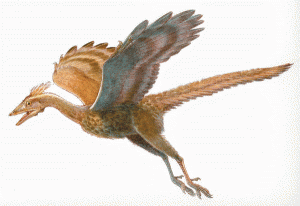 [6/24/18: A correction brought to my attention by a reader. Originally I stated that Pterosaurs weren’t capable of flight. However, Pterosaurs were capable of true flight according to the current consensus. I was working off old information at the time I wrote this 3 years ago. Also, for the sake of clarity, when I say “very large human” I am referring to guys like this:
[6/24/18: A correction brought to my attention by a reader. Originally I stated that Pterosaurs weren’t capable of flight. However, Pterosaurs were capable of true flight according to the current consensus. I was working off old information at the time I wrote this 3 years ago. Also, for the sake of clarity, when I say “very large human” I am referring to guys like this:

Who are, thankfully, also incapable of flight.]
Soooo, how exactly do you resolve that issue?
Flight
The first uncomfortable change that would have to be made to bring dragons in line with science rather than vice-versa is that we would have to start making them more wing than dragon. Rather than a pair of wings attached to the back of a lizard, we would have to start leaning them more towards creatures which evolved specifically for flight by making the wing a larger percentage of their body and foregoing the front legs in favor of reducing weight with relatively unnecessary limbs. This concept actually exists already in a related creature called the Wyvern.
Wyverns were essentially dragons that had only two legs and a pair of wings. They’re not often our depiction of choice because they’re not the thing that has been branded into our brains. But if we’re to start leaning towards something more likely to exist in a scientific world, that would be it. With the higher ratio of wing to body, the dragon may be able to overcome its size and be able to be that agile creature we’ve got in our mind. Just, one other thing, they still probably wouldn’t be able to fly without a specific enhancement.
The sternum would be pronounced on anything capable of actual flight. Birds and bats both possess a large blade-like projection from their sternum for their chest muscles to attach to allow for the strength required to both keep the wings steady and flap them to gain altitude. If our scientifically accurate dragon were actually capable of flight and not just gliding, it would have to have this adaptation as well to be able to carry its massive weight. This would mean the chest of a dragon would be incredibly developed and extremely powerful. Combined with other natural adaptations that birds have developed and there’s a chance that a wyvern-style dragon could fly despite its size.
But, even with the physical out of the way, we have to ask how likely the rest would be…
Intelligence
Often, in the mythology, dragons are among the most intelligent creatures in the world. They are often said to possess great wisdom, be able to communicate with humans, and be more cunning than most creatures. In some instances they are believed to be incredibly knowledgeable in magic or possess psychic abilities. But that would raise the question – why haven’t they taken over the world already?
A lot of stories try to work around this by making them incredibly rare to the point of near extinction or in a hibernation period that lasts eons. Neither of these makes a whole lot of sense when poked at long enough if they’re both so impressively powerful and intelligent at the same time. A creature capable of flying and tearing smaller animals apart combined with keen intelligence would be the apex predator long before we would be. So you have to come to the next point of uncomfortable adjustments.
Maybe they’re just really smart for an animal.
Not to say that they should be stupid, but not smart enough to be fully capable of mastering human speech. If we’re going to look at the possibility that dragons are a thing that could exist in our world we would have to be able to understand why they aren’t the thing in charge. Our complexity gave us the ability to dominate this world and clearly dragons with heightened intelligence would be more complex than we are. Even if their population growth is amazingly slow compared to ours, they would only have to organize against us once.
Instead, it would be reasonable to expect that they could be intelligent but not necessarily on equal or greater level than we are. We’ve seen cunning predators before and, given the fact we’re seeing them relate to dinosaurs and birds in a lot of the physiology that would make sense of them, we’ve seen birds of fairly high intelligence too.
So, if we were to figure that these dragons were to have taken some similar evolutionary steps as birds, it would make sense to say that the smartest of them could be compared to crows. Anything more significant than that and we would have to ask ourselves how we managed to come out ahead of these creatures, especially if we keep the most ridiculous of their traits…
Breathing Fire
The part that is the most fantastic of all is the idea that a creature could breathe fire. Despite the wonders of evolution, there has been no creature on Earth that could spontaneously produce a flame from just the things in its body. However, that’s not the only method of attack dragons have had in the various incarnations over the years and some of the alternatives are a lot more likely.
Quite a few creatures in the natural world have something similar to the common idea of “breath weapons”. It is incredibly common for venom, chemicals, or even acid to be spit by animals in the wild – especially reptiles. In fact, if we were to give a breath weapon to our “realistic” dragon, it would likely originate from glands similar to those found in several species of snake, the venom sacs located under and behind the eyes and usually resulting in a slightly different skull that creates the distinctive arrow-head shape vipers tend to have.
So, structurally, our realistic dragons would be considerably different than the old interpretation to accommodate traits like the chemical glands in its skull and the flight alterations from before. But one would have to ask, just for curiosity’s sake – is it possible that fire could happen?
Well, strangely, yes.
The point of this is not to go into apologetics where we bend science to fit the mythology. But, as with all the other cases, the idea is to take something that actually exists in nature and then apply that to the general idea of dragons. While a giant flying beast wouldn’t look like the creature of legend, in a strange way the weirdest aspect is, while rare, completely plausible.
Infamously, the Bombardier Beetle has the ability to produce searing hot chemicals from its rear that it can fire at predators with ease. These chemicals heat to nearly 100 degrees Celsius, evaporating a percentage of them rapidly, and then shoot out in an explosion. While not an actual flame, the very fact it adapted to be able to create an exothermic chemical reaction within its body suggests that you could have almost any chemical reaction happen inside a biological creature with the right adaptations.
In fact, the only thing that prevents the Bombardier Beetle from being destroyed by its own reaction is the fact its body immediately slams closed the valves in the process of releasing the chemicals. Without this defense, the reaction would get out of control and kill the beetle itself as it’s trying to defend itself.
Conclusions
So, in conclusion, if one were to try to depict a dragon “realistically”, it would have a lot of biological quirks and limitations not found in legend. First, it would be very unlikely for it to reach the size of something such as Smaug. If it did get that large, it wouldn’t be very capable of flight. For it to be able to fly it would probably have to look more like a Wyvern and have a very pronounced chest. And, while possible, breathing fire would require…
Some truly fantastic adaptation.
(I write novels. So far, no dragons, but I’m tempted. Catch me on twitter to see if I ever bite the bullet.)



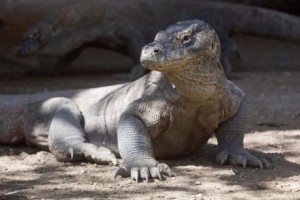

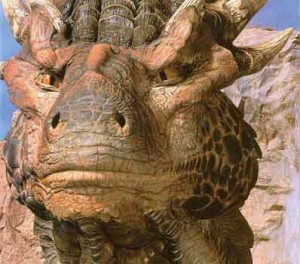
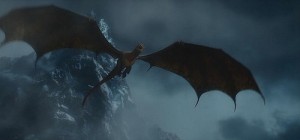
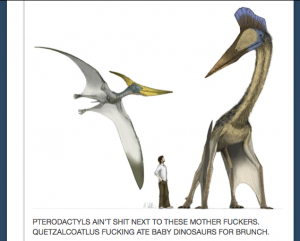
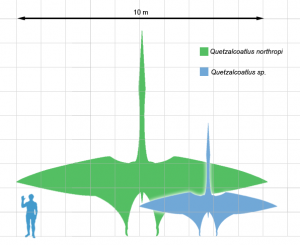
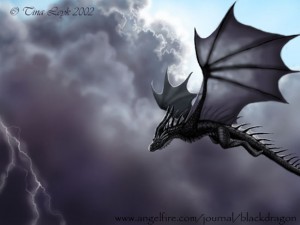
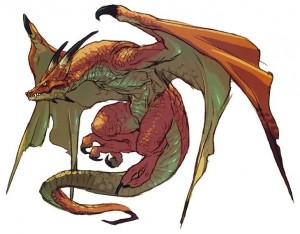

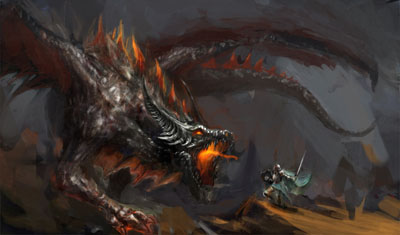
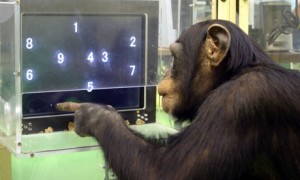
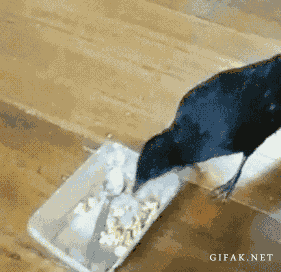
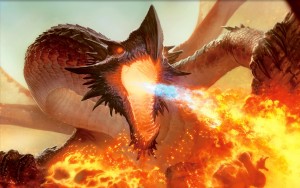
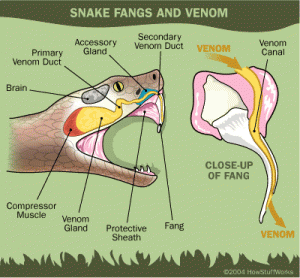
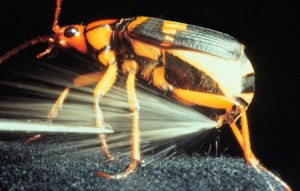





Quite interesting indeed, I myself have a few ideas:
– To make the dragon a bit larger, you could add feathers to it to increase their flight ability similar to birds as well as providing warmth, in fact some dragons are depicted as such and would explain how some are described as living up in the arctic circle.
– They could be intelligent and could speak as some animals are able to, such as the African Grey Parrot, which can imitate human speech to an amazing degree and has self awareness.
– I don’t agree with the fire idea also, it is more likely that either highly poisonous venom is sprayed through holes in their fangs similar to the Indian Spitting Cobra, or acid is vomited up and sprayed in a line like a weaponised version of acid reflux.
Are you not a fan of the gut bacteria producing hydrogen idea? If they kept a bladder of hydrogen, methane, and other flammable gasses in their chest, they could increase their boyancy to help them fly. Their love of treasure could be explained as an instinctual hoarding giving them metals to spark or catalyze a reaction when they violently breathe out some of their gasses.
It could create some interesting trade offs. A dragon with such a mechanism wouldn’t want to use its fire breath unless it had no other option. They would only have a finite amount of gas, and using too much of it would limit their ability to fly as well. Out in the open, a dragon would prefer to strike from above and use their talons and jaws. Caught in a cave, they may use their breath since they couldn’t fly anyway.
At the beginning I also saw that theory very attractive, but it has its drawbacks:
the gas occupies more space than the liquid in terms of performance and inside the dragon is already occupied by air sacs that are indispensable to add enough O2 to the lungs. Besides, being more volatile, if the dragon blows while it advances in full flight or with present wind, the flame would revert to its snout and face; even if it were fireproof, the attack would be frustrated (to check it, exhale with your mouth open while you are cycling and you will feel the hot air crashing on your chin or face).
Finally, the problem of the detonator (spark) is the humidity of the dragon’s muzzle, that is to say the saliva, (not to mention that from time to time he has to hydrate itself from time to time and the blood of his prey while he eats).
Therefore, it would be more plausible that it endowed glands with hypergolic or pyrophoric substances. In addition, with the viper tusk model it would allow him to shoot from the front of the snout and thus avoid the risk of burning its palate and tongue.
I hope my contribution will be useful. Greetings.
Mostly accurate! Very wrong about pterosaurs. To begin with, most of the evidence is on the side of most if not all late Cretaceous pterosaurs being able to fly (this includes the Quetzalcoatlus). The late Cretaceous period also happens to be when the archeopteryx lived, however, the two are only distantly related. In fact, these two aren’t even both dinosaurs.
P.S. Not to belabor my criticism but I found your comparison of the 500 pound Quetzalcoatlus’ weight to that of “very large human being” to be abusive. A fairer comparison would – in my opinion – be a tiger or other large predator ranging from 350 to 500 pounds.
I admit I made an error in writing about the Pterosaur’s flight ability because the last time I did any extensive reading on dinosaurs, pterosaurs, et. al. the general consensus was that they couldn’t fly and the first few articles that I found on the subject back in 2015 were discussing the fact it was still hotly debated and I just assumed that they hadn’t discovered anything new yet. My mistake, I’ll make a correction on that front. Also, I am aware that Archeopteryx is a Dinosaur and the Quetzalcoatlus is a Pterosaur and I am under no impression those are the same things. The mention of Archeopteryx was in regards to the fact that, at the time, I wasn’t aware they’d settled the Pterosaur flight debate and was pointing at the first widely agreed example of true flight.
As for the “abusive” weight issue, what I said was accurate and fitting for the context of this post and its intention. This post was intended mostly for a speculative fiction audience who are only sometimes versed in subjects like zoology and paleontology. Generally fiction authors have a really bad habit of mentally scaling predators up by default. We have this mental image that kind of puts these creatures as naturally larger than any human can be. So if I were to say just “tiger”, someone like you would probably know off the top of their head that scales between 350 to 500 pounds for most breeds. But I know from experience of talking to other fantasy authors that when you say “tiger”, most people would start to think of the likes of the Siberian at 800.
So by placing them at “very large” for a human, there’s a chance a fiction author would avoid the usual enormous mental image and instead picture the likes of an Andre the Giant (520 lbs), Akebono Taro (551), or several other examples of exceptionally heavy people. Though you may think it “abusive”, both of the people I just listed weigh in the ranges of a Quetzalcoatlus and a lot of people in North America have met at least one guy in the 400+ range (unfortunately), so it’s factually accurate and it might make people second guess the general idea of a flying tank made of meat and dense bones. More than likely they’ll still blow off what I’ve said and just substitute the largest predator they can find anyway, leaving us with polar bear sized 990 pound dragons. That would still be heavier than the Quetzalcoatlus, but at least they may stop to think about it.
Anyway, thanks for the correction on the flight status and I’ll throw in a picture of Andre for good measure so people understand what I mean by “very large”.
Archaeopteryx was a dinosaur and a bird and it lived in the Jurassic not the Cretaceous.
Just a reminder.
Wanted to reply to Ezra Dube.
Sorry!
here is a compilation in an image (with animation): https://imgur.com/gallery/y1x3uC4
In addition, the tail could be thin and rigid to reduce its weight and work better as a rudder.
And the horns (that traditionally form a crown with the points backwards, on the later part of the skull) can serve for the visualization and not to charge, due to the difficult thing that it would be to assemble the heads while they fly and because they could not hit with them to your location. The horns would be longer in the males than in the females and at the same time define the age of the dragon.
Could dragons having hollow bones (like birds) make it easier to fly?
Oh sure, but even with hollow bones the size would be under constraints. The largest flying bird in the fossil record (the giant teratorn) was still smaller than the quetzalcoatlus and the bones of pterosaurs already had incredibly thin outer walls (which is awesome for flight but terrible for fighting off knights or facing siege weapons). You could theoretically have those bones reinforced with a more durable material than your average bone, some sort of natural carbon nanotube structure, but that would still only buy so much additional lift. Mind you, even though it didn’t weigh a lot for its size, the Quetzalcoatlus was still huge and the Giant Teratorn was too, so when talking about size limits we’re just talking “it’s big enough to ride or carry you off with relative ease, but not quite big enough to topple the castle walls”.
On intelligent dragons:
Once an apex predator such as that reaches the point of complete domination, with such high intelligence, they will move on to creating a culture, and then a society. Once that society is advanced enough, they don’t really need to constantly hunt for prey – it would be quite easier to domesticate the food.
The point here being that, as we do right now even though we very much are the apex predators in the ecosystem (albeit through technology), not only do we let other animals live, we preserve them. Humans could be allowed to evolve after dragons, who simply view them as a lesser species.
This would of course run a little against the fable and mythology, but speaking of realism that’s a perfectly viable solution to coexistence. Cohabitation? Once humans are advanced enough, it can go either way – they wipe us out as we threaten to develop a civilisation, or we exist in some sort of arrangement.